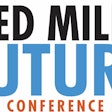
The pursuit of energy efficiency is a critical objective for feed manufacturers but must be achieved without compromising productivity to remain economically viable. Jerry Plessing, industry consultant for Rockwell Automation, explored the intertwined considerations for production and energy consumption in his presentation Save your energy: A manufacturer’s guide to energy efficiency at Feed Mill of the Future Conference.
Plessing stressed that balancing energy efficiency with production requirements presents a challenge in that strategic decisions must support the broader objectives of profitability and meeting customer demands.
"We talk a lot about ‘WAGES’ – water, air, gas, electric and steam – because of their interdependence," Plessing said. “Some things we can do to improve energy efficiency may not be the best in terms of production.” Jerry Plessing, industry consultant, Rockwell AutomationPaul Ward
Jerry Plessing, industry consultant, Rockwell AutomationPaul Ward
To strike the right balance, Plessing outlined a journey of key phases manufacturers can advance through toward optimal energy efficiency.
“We find this is really a ‘journey’ concept — it's not going to happen overnight,” Plessing said. “There is a roadmap of different phases in that journey, and it starts with connect. Then it goes into analyze — a more reactive activity. And then we start optimizing to move into being proactive, and eventually plant control based on optimized parameters.”
Data is key to four phases
The initial phase, connect, emphasizes the importance of measurement and comprehensive data collection on power consumption, material flow and other critical parameters. From steam flow at the boiler level to specific conditions within individual pelleting lines, comprehensive data sets enable thorough analysis and informed decision-making.
"We start here because we can't control what we’re not measuring," he said. “A lot of that information is coming directly out of our automation systems that we have in place. The challenge here, though, is that not all the information is coming necessarily from the automation system. Some data is coming from other sources.”
Collecting data from these various sources is critical, because Plessing said as manufacturing facilities evolve, energy inputs will be incorporated as raw material alongside traditional inputs — such as grains, feed additives and proteins.
“Many times we're collecting steam flow capacity, but doing so just at the boiler,” he said. “I may have multiple pellet mills in my facility and if I'm not taking that steam consumption down to the mill level, how am I going to optimize that particular mill’s operation? Make sure to get granular and detailed enough information for that.”
Plessing said obtaining the granularity needed to properly analyze facility data may require additional instrumentation or expanding the control system.
The analyze phase marks a shift toward proactive engagement with data, moving beyond mere reporting to actionable insights. This involves comparing and identifying patterns and relationships within data sets to contextualize it. Plessing stressed the importance of data organization in this phase to better utilize the information gathered.
“This allows us to more easily compare mill to mill, vendor to vendor, control vendor to control vendor, and location to location, because the data comes across in the same context,” Plessing said. “The data behind it may come from different locations, but it’s looking at the same model.”
Mathematical models, informed by empirical research and operational expertise, play a crucial role in translating data insights into actionable strategies.
Analytics evolve into optimization and control
Plessing described the optimize phase as “where we make the data useful,” and feed manufacturing operators transition from being reactive to proactive. Facility optimization provides insight and decision support with advanced analytics.
The roadmap finishes at the control phase, where advanced operational technology enables real-time responsiveness and adaptive control mechanisms. Here, manufacturing plants leverage data models on the device level to adjust operational parameters to maximize energy efficiency without sacrificing productivity.
Plessing said sophisticated control systems allow manufacturers to optimize outcomes by imposing constraints to minimize energy consumption or maximize production output within defined energy thresholds.
“Now the controller can quickly respond to variabilities in material flow, allowing us to keep production at peak energy efficiency,” Plessing said. “We also implement constraints because, again, we want to be energy efficient, but not at the cost of lost productivity, so productivity can be set at a minimum level as a constraint even though it may have additional energy costs.”
Conversely, Plessing said the model can maximize productivity with constraints set on energy inputs in terms of electrical or gas consumption, or electrical or gas costs.
While advancements in analytics and control systems offer valuable tools, Plessing cautioned against viewing technology as the sole solution for energy optimization. Operators must be trained to interpret data within a broader context to optimize energy consumption while maintaining productivity.
As feed manufacturers begin to explore energy optimization strategies, following the roadmap Plessing outlined offers guidance from connect to analyze to optimize and, finally, control.







